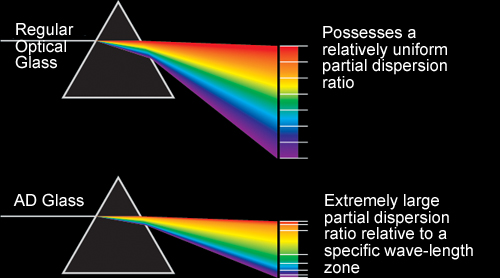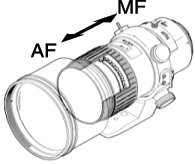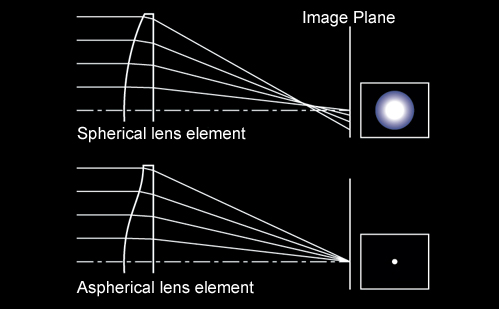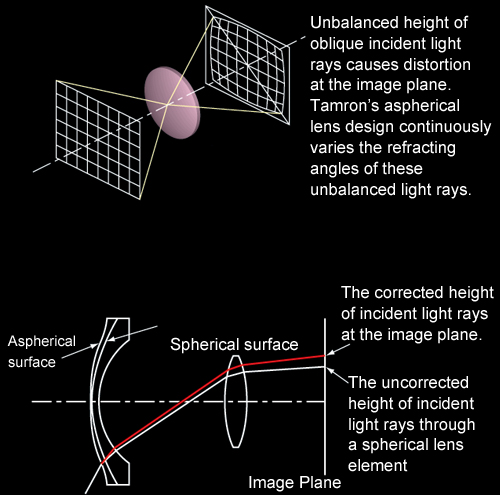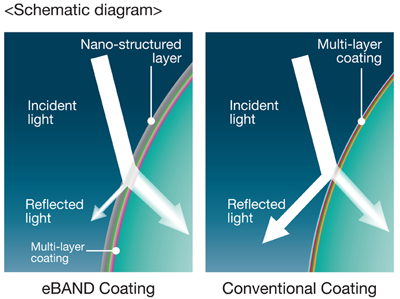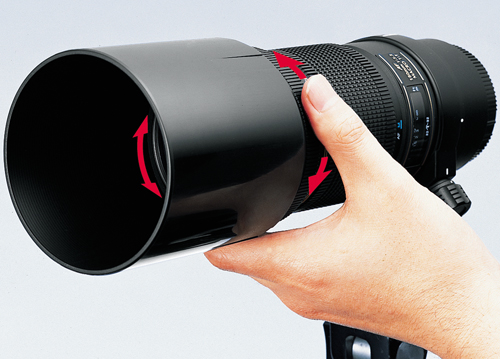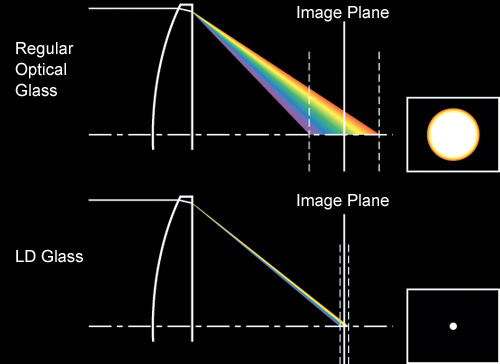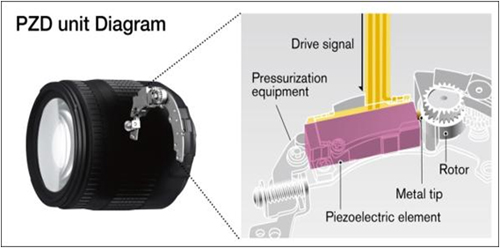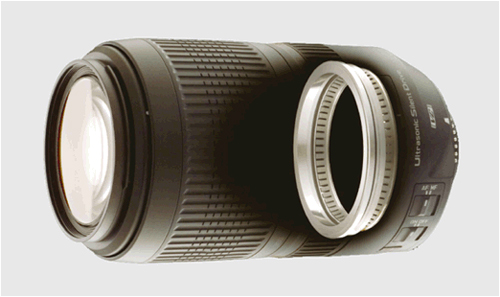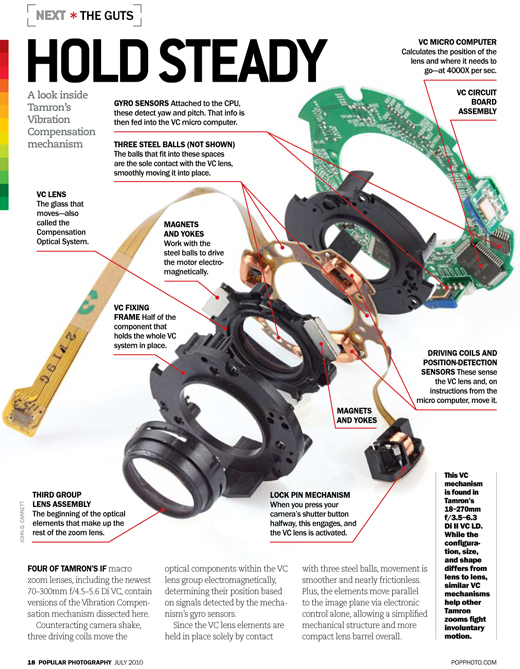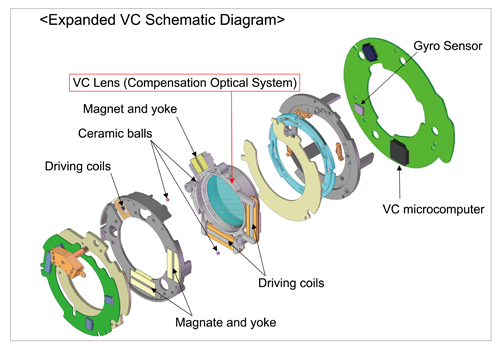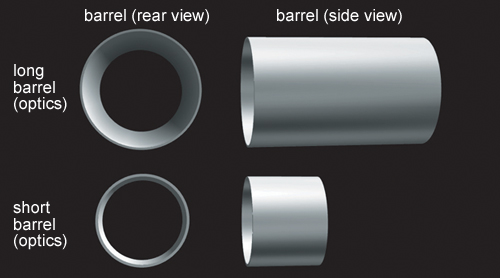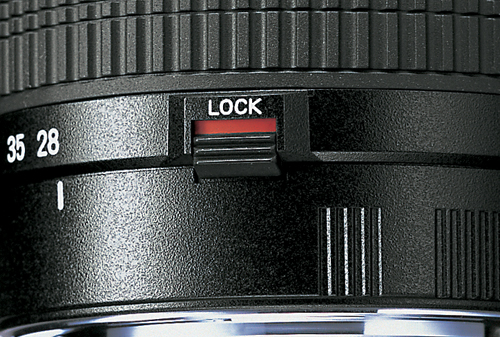Anomalous Dispersion (AD) for Better Colour Correction
Anomalous dispersion (AD) glass is a special type of optical glass that is used to achieve more precise control of chromatic aberrations, thereby enhancing overall imaging performance. Glass of this type provides an abnormally large partial dispersion ratio (amount of diffraction) for light of specific wavelength ranges (colours) within the visible spectrum. By combining AD glass having these special characteristics with elements made of normal glass having different dispersion characteristics, it is possible to control the dispersion factors of a specific wavelength. This enhanced level of control results in much lower levels of on-axis (central) chromatic aberration for telephoto lenses (or zooms used at tele-photo settings) and a significant reduction of lateral (peripheral) chromatic aber-ration for wide-angle lenses (or zooms used at wide-angle settings.)
The difference in partial dispersion factors between normal optical glass and AD glass elements (typical diagram)
AF/MF
Auto-focus/Manual-focus (AF/MF) Switch Mechanism on the Focus Ring
The ability to switch quickly between auto-focus (AF) and manual-focus (MF) is a great asset in many types of shooting, especially sports and nature photography. This is easily accomplished with Tamron’s ingenious AF/MF system. By simply sliding the focus ring back and forth between the two positions you can select either the AF or MF focusing position. In manual-focus mode Tamron lenses provide smooth, precise manual focusing by turning their wide, well-textured focusing rings.
Hybrid Aspherical Elements Provide the Ultimate in Image Quality and Compactness
Tamron uses several hybrid aspherical lens elements in many lenses bearing the Aspherical designation. These innovative optics allow us to achieve the ultimate in image quality, and at the same time produce lenses that offer remarkable zoom ranges in extraordinarily compact packages. By perfecting theses cutting-edge advances for series production, Tamron has advanced the state of optical design, and virtually eliminated spherical aberration and image distortion from the high-power-zoom series.Through the effective application of Hybrid Aspherical Technology, one lens elemen tcan take the place of multiple elements without compromising performance. This is what allows us to produce remarkably compact long-range lenses that deliver a uniformly high level of image quality at all focal lengths and apertures.
Digitally Integrated Lenses for Top Imaging Performance
Di (Digitally Integrated Design) is a Tamron designation that applies to lenses that have been optimized for digital capture using advanced multi-coating techniques and optical designs that assure excellent image quality across the entire picture field. Because of these characteristics, Di lenses provide outstanding performance on cameras with full-frame and APS-C format sensors as well as on 35mm film.
Digitally Integrated Lenses Optimized for APS-C Format Digital SLR Cameras
Tamron Di-II lenses are engineered expressly for digital SLR cameras with image sensors commonly referred to as APS-C, measuring approximately 24mm x 16mm. Rendering an ideal image circle for APS-C sensors, Di-II lenses also include properties to optimize digital imaging performance.
Tamron Di III lenses are engineered specifically for mirrorless interchangeable-lens cameras with no internal mirror box or pentaprism, adopting an optical design that matches the characteristics of the digital camera. (Note: These lenses cannot be used with digital SLR cameras with built-in mirror box or conventional 35mm film SLR cameras).
![]()
eBAND (Extended Bandwidth & Angular-Dependency) Coating
This new coating technique developed by Tamron deploys a nano-structured layer (1nm = 1/1,000,000mm) of ultra-low refractive index, with dimensions smaller than the wavelengths of visible rays of light. This nano-structured layer coupled with the sophisticated multiple layer coatings underneath, yields significant anti-reflection properties, efficiently reducing undesired flare and ghosting to an absolute minimum to deliver sharp, crisp images.
![]()
FEC (Filter Effect Control) function enhances operational ease of Polarizing Filter use
The Filter Effect Control is designed to rotate the filter to the desired position while the hood is attached. This is accomplished by turning the FEC ring that in turn rotates the portion of the filter mount where the filter is mounted.
Full Time Manual Focus makes fine tuning easy
All Tamron lenses have high autofocus precision and are designed to capture subjects easily in almost any situation, yet sometimes a photographer wants to fine tune and make adjustments on the fly. The integration of full time manual focus offers just that: instead of fumbling with switches, photographers can switch from autofocus to manual focus by simply adjusting the focus ring. This feature helps the lens produce impressive results even in telephoto situations where the depth of field is narrow.
![]()
HIGH INDEX, HIGH DISPERSION GLASS
High Index, High Dispersion (HID) Glass for Better Colour Correction
The use of HID (High Index, High Dispersion) glass elements in a lens can also be used to minimize on-axis and lateral chromatic aberrations that are the greatest hindrances to achieving high image quality. HID glass is another tool in the lens designer’s arsenal that has allowed Tamron to design and produce complex lenses such as long-range zooms that are conveniently compact and lightweight, and deliver outstanding performance.
Internal Focusing (IF) System
Internal focusing (IF) provides numerous practical benefits to photographers including a non-rotating front filter ring that facilitates the positioning of polarizing and graduated filters, and more predictable handling because the lens length does not change during focusing. Even more important, Tamron’s Internal Focusing (IF) system provides a much closer minimum focusing distance (MFD) throughout its entire focusing range. In addition, IF improves optical performance by minimizing illumination loss at the corners of the image field, and helps to suppress other aberrations that become more troublesome at different focusing positions.
Low Dispersion (LD) Glass for Greater Lens Sharpness
Low dispersion (LD) glass elements in a lens help reduce chromatic aberration; the tendency of light of different colours to come to different points of focus at the image plane. Chromatic aberration reduces the sharpness of an image, but glass with an extremely lowdispersion index, has less of a tendency to separate (defract) a ray of light into a rainbow of colours. This characteristic allows the lens designer to effectively compensate for chromatic aberration at the center of the field (on axis), a particular problem at long focal lengths (the telephoto end of the zoom range), and for lateral chromatic aberration (towards the edges of the field) that often occurs at short focal lengths (the wide-angle end of the zoom range.)
Moisture-resistant construction helps prevent moisture from penetrating the lens.
PIEZO DRIVE
Piezoelectric drive replaces traveling wave energy with more efficient standing wave energy for higher AF performance with less weight and bulk. A vital contributor to compactness, PZD focuses quickly and precisely, assuring sharper results in demanding conditions with speed that captures spontaneous moments crisply—moments that might otherwise be lost to image softness. PZD is exceptionally quiet, making it ideal for nature, live performance shooting, golf and other conditions that demand quiet operation.
Rounded Diaphragm
Using a rounded diaphragm, this lens achieves spectacular blur effects. By distinctively blurring backgrounds and foregrounds this high-speed lens creates images that bring your subject into focus, thus to life.
Super Performance for Discriminating Shooters
Tamron SP (Super Performance) series is a line of ultra-high-performance lenses designed and manufactured to the exacting specifications demanded by professionals and others who require the highest possible image quality. In creating SP lenses Tamron’s optical designers put their foremost priority on achieving superior performance parameters—they are all designed to a higher standard with little regard for cost constraints. As a result, Tamron lenses bearing the SP designation feature impressive and innovative designs that have established an enviable reputation for excellence among those knowledgeable photographers that demand the very best.
Tamron’s USD works with the high-frequency ultrasonic vibrations that are produced by a ring called a ‘stator’. Energy from the vibrations is used to rotate an attached metallic ring known as the ‘rotor’. Piezoelectric ceramic, an element that produces ultrasonic vibrations when voltage of a specific frequency is applied is arranged in a ring formation on the stator. This electrode configuration of piezoelectric ceramic causes two ultrasonic vibrations to occur in the stator.
By effectively combining these two ultrasonic vibrations, it is possible to convert the energy from the vibrations that produced simple motion into energy known as ‘deflective traveling waves’, which then moves around the circumference (rotation direction) of the ring.
With the USD, the friction between these deflective traveling waves created on the metallic surface of the stator and the surface of the rotor produce force, causing the rotor to rotate. The focusing ring lens, which is linked to the rotor, is thus moved, creating a fast and smooth auto-focus drive.
Tamron’s Unique State-of-the-Art In-Lens Image Stabilization System
Handheld camera shake is the leading cause of blurry and unsharp pictures. Several leading companies now make lenses with built-in optical image-stabilization systems that sense the amplitude and direction of the shake and compensate by moving optical groups within the lens. Tamron’s exclusive new Vibration Compensation (VC) system that’s built into the Tamron AF28-300mm F/3.5-6.3 XR Di VC LD Aspherical (IF) Macro and the Tamron AF18-270mm F/3.5-6.3 Di-II VC LD Aspherical (IF) Macro lenses performs a similar function, but it executes it much more effectively due to its innovative breakthrough design.
While other image-stabilization systems can only correct the effects of camera shake in horizontal or vertical planes, Tamron’s VC system uses a tri-axial configuration that employs three pairs of driving coils and low-friction ball bearings placed around the shake-compensating optical group to produce, in effect, a free-floating shake compensator. This simple, elegant system is able to compensate for camera shake that occurs in diagonal direction as well as for up-and-down and side-to-side movements. Furthermore, due to its simple, low-friction design it is more responsive and durable than previous systems. The Tamron 28-300mm VC and 18-270mm VC lenses incorporate a highly sensitive and accurate gyro sensor for detecting even the slightest hand shake, and that,combined with a 32-bit RISC CPU and Tamron’s proprietary Algorithms and actuator, provides unequalled real-world performance. The bottom line: Tamron VC provides up to a 4-stop advantage in shooting sharp handheld pictures at slower shutter speeds along with a smooth, stable viewfinder image that is the envy of other shake-control systems. You can expect to see the VC feature built into more Tamron lenses in the future.
VC schematic for model A007
EXTRA LOW DISPERSION
A sophisticated XLD (Extra Low Dispersion) lens element made from specialized high-grade glass that has lower dispersive properties than standard LD lenses (where refraction causes the dispersion of white light into spectral hues). The dispersive properties of the XLD lens are at a level similar to fluorite, and in combination with LD elements make for an optimal optical design that delivers best in class resolution with advanced axial chromatic and magnification aberration correction – major inhibitors of image quality enhancement. The result is a lens that delivers sharp contrast and better descriptive performance throughout the entire zoom range.
EXTRA REFRACTIVE INDEX GLASS
Special Glass for Better Performance and More Compact Lens Designs
XR (Extra Refractive Index) glass can bend light rays at steeper angles, thereby decreasing the physical length of the lens while enhancing imaging performance by minimizing optical aberrations. This has allowed Tamron to develop a line of shorter, smaller-diameter, lighter lenses without sacrificing lens speed, and actually upgrading image quality compared to older designs. XR glass is costlier than conventional glass but it yields enhanced optical power distribution, making possible many of the outstanding and innovative lens designs that bear the XR designation. XR glass, with its superior light-bending power, makes it possible to design a short-barrel lens with the same light-gathering ability (aperture value) as a long-barrel lens—even with a smaller lens diameter. By using this principle Tamron has been able to shorten the length of the entire optical system and produce lighter, more compact lenses of the same speed, and also to provide greater zoom ranges in lenses that are much more convenient to carry and hand-hold.
Zoom Lock (ZL) Feature
Another original Tamron mechanical engineering concept is the Zoom Lock (ZL), a simple convenience feature that prevents undesired extension of the lens barrel when carrying the camera/lens unit on a neck strap.
